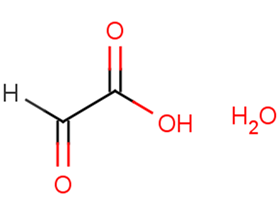
Glyoxylic acid monohydrate
CAS No. 563-96-2
Glyoxylic acid monohydrate( Formylformic acid )
Catalog No. M19632 CAS No. 563-96-2
Glyoxylic acid or oxoacetic acid is an organic compound that is both an aldehyde and a carboxylic acid.It is an intermediate of the glyoxylate cycle which enables certain organisms to convert fatty acids into carbohydrates. The conjugate base of glyoxylic acid is known as glyoxylate.
Purity : >98% (HPLC)
 COA
COA
 Datasheet
Datasheet
 HNMR
HNMR
 HPLC
HPLC
 MSDS
MSDS
 Handing Instructions
Handing Instructions
| Size | Price / USD | Stock | Quantity |
| 1G | 43 | In Stock |


|
Biological Information
-
Product NameGlyoxylic acid monohydrate
-
NoteResearch use only, not for human use.
-
Brief DescriptionGlyoxylic acid or oxoacetic acid is an organic compound that is both an aldehyde and a carboxylic acid.It is an intermediate of the glyoxylate cycle which enables certain organisms to convert fatty acids into carbohydrates. The conjugate base of glyoxylic acid is known as glyoxylate.
-
DescriptionGlyoxylic acid or oxoacetic acid is an organic compound that is both an aldehyde and a carboxylic acid.It is an intermediate of the glyoxylate cycle which enables certain organisms to convert fatty acids into carbohydrates. The conjugate base of glyoxylic acid is known as glyoxylate. In humans glyoxylate is produced via two pathways: (1) through the oxidation of glycolate in peroxisomes and (2) through the catabolism of hydroxyproline in mitochondria. In the peroxisomes glyoxylate is converted into glycine by glyoxylate aminotransferase (AGT1) or into oxalate by glycolate oxidase. In the mitochondria glyoxylate is converted into glycine by mitochondrial glyoxylate aminotransferase AGT2 or into glycolate by glycolate reductase. A small amount of glyoxylate is converted into oxalate by cytoplasmic lactate dehydrogenase. Glyoxylic acid is found to be associated with primary hyperoxaluria I which is an inborn error of metabolism. Under certain circumstances glyoxylate can be a nephrotoxin and a metabotoxin. A nephrotoxin is a compound that causes damage to the kidney and kidney tissues. A metabotoxin is an endogenously produced metabolite that causes adverse health effects at chronically high levels. High levels of glyoxylate are involved in the development of hyperoxaluria a key cause of nephrolithiasis (commonly known as kidney stones). Glyoxylate is both a substrate and inductor of sulfate anion transporter-1 (SAT-1) a gene responsible for oxalate transportation allowing it to increase SAT-1 mRNA expression and as a result oxalate efflux from the cell. The increased oxalate release allows the buildup of calcium oxalate in the urine and thus the eventual formation of kidney stones. As an aldehyde glyoxylate is also highly reactive and will modify proteins to form advanced glycation products (AGEs).
-
In Vitro——
-
In Vivo——
-
SynonymsFormylformic acid
-
PathwayOthers
-
TargetOther Targets
-
RecptorOthers
-
Research Area——
-
Indication——
Chemical Information
-
CAS Number563-96-2
-
Formula Weight92.05
-
Molecular FormulaC2H4O4
-
Purity>98% (HPLC)
-
SolubilityDMSO:10 mM
-
SMILESO.OC(=O)C=O
-
Chemical Name——
Shipping & Storage Information
-
Storage(-20℃)
-
ShippingWith Ice Pack
-
Stability≥ 2 years
Reference
1.Lee S H Kim S O Chung B C . Gas chromatographic–mass spectrometric determination of urinary oxoacids using O-(23456-pentafluorobenzyl)oxime-trimethylsilyl ester derivatization and cation-exchange chromatography[J]. Journal of Chromatography B 1998 719(1-2):1-7.
molnova catalog



related products
-
Protein Kinase C Pep...
Protein Kinase C Peptide Substrate targets specific cell spacers ina manner that is dependent on second messengers and specific adaptor proteins in response to extracellular signals that activate g protein-coupled receptors, tyrosine Kinase receptors, or tyrosine kinase-coupled receptors.
-
Amosulalol
Amosulalol is an Adrenergic Agent.
-
trans,trans-2,4-Deca...
trans,trans-2,4-Decadienal is a lipid peroxidation product of linolieic acid



 Cart
Cart
 sales@molnova.com
sales@molnova.com


